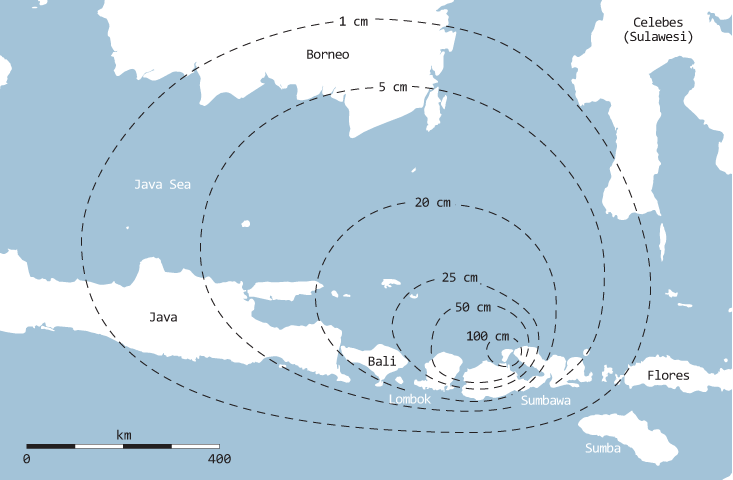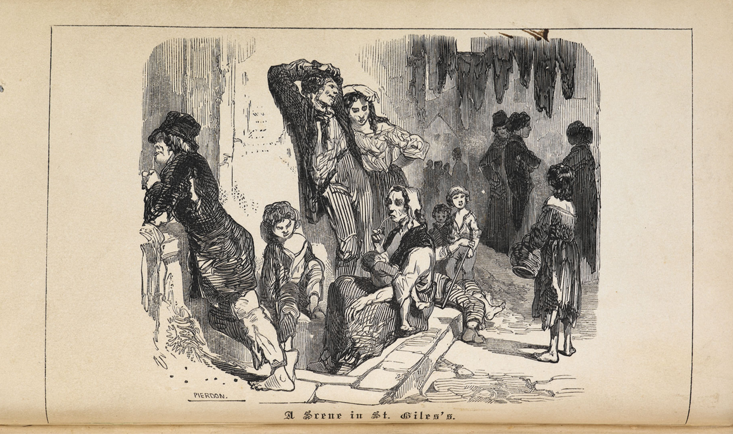The volcano that covered the earth and gave birth to monsters
Three years of darkness and cold led to an increase in crime, poverty and the emergence of a literary masterpiece

Two hundred years ago, there was the greatest volcanic eruption in the history of the Earth. The Tambor Stratovolcano , located on the Indonesian island of Sumbawa, exploded with catastrophic force in April 1815. [ This eruption was the largest in terms of ejected material. The loudest eruption is considered to be an explosion of the volcano Krakatau in 1883 / approx. trans. ]
After a thousand years of hibernation, the volcano took only a few days to devastating devastation of its entrails and subsequent collapse. The concentrated energy of this event greatly influenced humanity. Shooting its contents into the atmosphere with incredible force, Tambora ensured that volcanic gases reached the upper layers of the atmosphere, which led to a change in the seasonal rhythms of the global climate system and plunged human communities around the world into chaos. Small particles in the stratosphere eclipsed the sunlight, and led to the onset of a long and most destructive period of extreme weather conditions from all that our planet has seen over a thousand years.
For several weeks, a cloud of stratospheric ash circled the planet at the equator, and spoiled the global climate system at all latitudes. Five months after the eruption, in September 1815, the enthusiastic meteorologist Thomas Forster observed strange and spectacular sunsets in the town of Royal Tunbridge Wells in Kent near London. “A pretty dry day,” he wrote in his weather diary, “but the bright blush of sunset is marked by stripes of red and blue.”

Ash rain: the map shows the density of ash deposition after the eruption of Tambory. The thickness of the cover is indicated in cm. The predominant trade winds carried ash clouds to the north and west, up to the islands of Sulawesi and Borneo, at a distance of 1,300 km. The eruption itself could be heard at a distance twice as large.
Artists across Europe have noted atmospheric changes. William Turner drew a bright red sky, a coloristic abstraction that looked like an advertisement for the pictures of the future. And in his studio on the shore of the Bay of Greifswald Bay in Germany, Caspar David Friedrich painted the chrome sky, which, as one scientific study showed, "corresponded to the optical aerosol depth" of a colossal volcanic eruption.
For three whole years after the eruption of Tambor almost all over the world, to be alive was to be hungry. In New England, 1816 was nicknamed the " year without summer, " or "one thousand eight hundred dead to death" year. The Germans called the 1817th "the year of beggars." Worldwide, harvests died from frost and drought, or were washed away by rain. Rural residents of Vermont survived on porcupines and boiled nettles, while peasants of Yunnan Province in China chewed white clay. Tourists traveling in France in the summer confused the crowds of beggars with the army marching along the roads.
One of these groups of English tourists next to his villa, located near Geneva, spent cold, crop-ruining days, by the fire, telling each other various horror stories. Mary Shelley's novel Frankenstein, or Modern Prometheus, imbued with a gloomy mood, bears the imprint of the Tambor summer of 1816, and her literary circle, which included poets Percy Shelley and Lord Byron, serves as a guide to the suffering world of 1815-1818.
According to geological measures, the eruption of Tambor occurred quite recently. The climate disaster of 1816-1818 offers us a rare and clear vision of the world, oppressed by extreme weather conditions, in which human communities frantically try to adapt to sudden and radical changes in temperature and precipitation, to the tsunami of hunger, disease, disorder and anxiety. This is an educational example of the fragile interdependence of people and natural systems.
On the island of Sumbawa, the beginning of the dry season in April 1815 meant busy time for local farmers. A few weeks later he was supposed to ripen rice, and Raja Sangar, a small kingdom on the northeast coast of the island, would send his people to harvest. Until then, the inhabitants of the village of Korex continued to work in the forests surrounding them, cutting down the sandalwood trees necessary for shipbuilders who worked on the busy trade routes of the Dutch East Indies .
On the evening of April 5, 1815, at about the time when his servants were supposed to cook him dinner, the Raja heard an incredible thunderclap. Perhaps his first thought was that the guards on the beach fell asleep and missed the pirate ship, which had crept up to the shore and had fired a volley of cannons. But instead, everyone stared at Mount Tambor. A torrent of flame burst from it into heaven, lit up the darkness and shook the earth beneath their feet. The sound was incredibly strong and hurt.
Huge flames burst from the mountain for three hours, until the dark ashen haze mixed with the natural darkness, and seemed to announce the end of the world. Then, just as suddenly as it had appeared, the pillar of flame disappeared, the earth ceased to shake, and the wailing to the inside of me roar ceased. In the next few days, Tamborus growled softly from time to time, and the ashes in the sky gradually disappeared into the distance.

The diagram shows the penetration of volcanic matter into the stratosphere. The sulfur dioxide of the volcano is chemically converted to sulfuric acid, an aerosol layer is formed, which reduces the flow of radiation from the sun and cools the surface of the planet, while the stratosphere itself warms up
In the south-east of the island, in the capital Bima, the colonial administration was quite concerned about the events of April 5 to send an official representative named Israel to investigate the details of the volcanic emergency on the Sangar Peninsula. By April 10, the official who had diligently set about work had already reached the foot of Tambory. There, in a dense tropical forest, around 7 pm, he became one of the first victims of the most powerful volcanic eruption in written history .
For several hours, the village of Korex and other villages of the peninsula were completely wiped off the face of the Earth, becoming victims of the suicidal spasm of Tambory. At this time, three separate columns of fire broke through with a cacophonic roar from a western elevation, eclipsed the light of the stars and united into a ball of rotating flame at a height higher than the height of the eruption that occurred five days before. The mountain began to glow due to streams of boiling liquid stone flowing along its slopes. By 8 o'clock in the evening, the terrible situation throughout Sangaru deteriorated even more, as hail of pumice mixed with hot rain and ash fell on the ground.
On the northern and western slopes of the volcano, entire villages totaling about 10,000 people were swallowed up by the hellish whirlwinds of flame, ash, boiling magma and hurricane winds. In 2004, a team of archaeologists from the University of Rhode Island unearthed the first remains of a village buried in an eruption: a house under three meters of volcanic pumice and ash. Among the remains of the walls, they found two charred bodies, perhaps a married couple. The woman, whose ribs had turned to coal because of the heat, was lying on her back, with her arms outstretched, holding a long knife. Her sarong, also charred, was still slung over her shoulder.
On the eastern side of the mountain, the rain of volcanic stones gave way to ashes, but the surviving peasants did not feel better. The impressive plinian eruption in the form of a jet (in honor of Pliny the Younger, who left the famous description of the vertical fiery column of Vesuvius) was not weakened, but the rapidly moving, glowing pyroclastic flows of magma and stones created huge clouds of asphyxiating dust. When these streams met cold water, secondary explosions occurred, increasing the amount of ash in the air. A huge curtain of steam and ash rose and surrounded the peninsula, creating a temporary microclimate of pure horror for those trapped in this trap.
First, a brutal hurricane covered Korekh, blowing the roof from houses. Gaining strength, he began to uproot large trees and launch them into the sea in the manner of burning arrows. Horses, cattle and people took to the air. Those who survived the cataclysm were overtaken by a new attack: giant waves. The team of the British ship, walking through the Strait of Flores, covered with ash and in the rain of volcanic stones, watched in a daze as the 4-meter-long tsunami swept rice fields and huts along the Sangar coast. Then, as if the joint cataclysms in the air and the sea were not enough, the earth itself began to descend when the collapse of the Tambory cone caused the soil to settle on the plain.
In the day without the sun following the cataclysm, all the roads of the inhabited eastern part of the island, between Dompu and Bima, were covered with unburied bodies. The villages were empty, the surviving inhabitants scattered in search of food. Forests and rice fields were destroyed, the island’s wells were poisoned by volcanic ash. As a result, about 40,000 people died in the next few weeks from disease and starvation, which led to an increase in the total number of human victims of the eruption to 100,000 people - the largest loss in history.
And although the eruptions themselves lasted about three hours each, the boiling cascade of pyroclastic flows went along the slopes of Tambory all day. Hot magma whipped from a fallen cone of a volcano down to the peninsula, and columns of ash, gas and stone rose and fell, feeding the stream. The fiery flood that swallowed the peninsula covered the distance of 30 kilometers with great speed, eventually covering an area of more than 550 square kilometers, which was one of the greatest pyroclastic events in the famous story. In just a few hours, it buried human civilization in the north-west of Sumbawa under a meter-high layer of smoking ignimbrit .

Charles Dickens, whose gloomy descriptions of weather and poverty define the image of Victorian London, grew up in a cloudy, penetrating atmosphere created by the Tambory eruption.
The cacophony of the Tambor explosions on April 10, 1815 could be heard hundreds of kilometers away. Throughout the region, government vessels went to sea in search of non-existent pirates and the invasion of hostile fleets. In the seas north of Makassar, the captain of the Benares vessel of the East India Company compiled a vivid description of the conditions created in this region by April 11:
Ash falls on us with rain, the general view of the surrounding reality was truly awful and disturbing. By noon, the light that was still visible in the eastern part of the horizon had disappeared, and impenetrable darkness enveloped the skies. The darkness remained so thick until the end of the day that I had never seen anything like it even on the darkest night; it was impossible to see my hand, even holding it close to my eyes.
Within a radius of 600 km, darkness descended for two days, and the ash cloud of Tambory spread to an area comparable in size to the United States. The whole territory of Southeast Asia was covered with hanging volcanic debris for a week. One dark day followed another, British officials worked by candlelight, and the number of deaths grew.
A month after the eruption, there was still a lot of dust in the atmosphere, and the sun seemed to be a blur. Drinking water contaminated with ash, rich in fluorine, spread the disease, and after the death of 95% of the rice plantings due to the eruption, the threat of famine turned out to be instantaneous and widespread. In desperate search for food, island dwellers descended to eat dry leaves and valuable horse meat. When the food crisis ended, Sumbawa lost half of its inhabitants due to starvation and disease, and most of the rest fled to other islands.
The monstrous effect of the Tambora eruption on world weather conditions was due to the unstable atmosphere at that time. Six years before, in 1809, a strong tropical volcano exploded. The subsequent cooling of the atmosphere was repeatedly enhanced by the Tambora eruption, which provided extreme volcanic weather for the next decade.
The flow of research that emerged after the discovery of the eruption of 1809 led to the fact that the decade from 1810 to 1819 was declared the coldest in the entire history of observations — a rather gloomy difference. In a study of 2008, it was concluded that the Tambora eruption had a strong effect on air temperature since 1610, and the volcano of 1809 was the second most powerful for the same time, its influence was two times less than that of Tambor. Two papers published the following year confirmed that the 1810s were "probably the coldest in the last 500 years," which was caused by two eruptions that took place in a short time.
An incredible eruption increased cooling to extreme values, the average annual temperatures of the decade fell by 1.5 degrees. This may seem small, but the constantly decreasing temperature was characterized by a sharp rise in extreme weather disasters — floods, droughts, storms, and summer frosts. The cold world climate of the 1810s had a devastating effect on agriculture, food supplies and diseases.
Scottish meteorologist George Mackenzie kept a systematic record of the state of the overcast sky from 1803 to 1821 in various places in the British Isles. In the previous period from 1803 to 1821, the number of clear sunny days averaged there was 20 pieces per year, and in the volcanic decade from 1811 to 1820, this number decreased to five. In 1816, the year without summer, Mackenzie did not fix a single sunny day at all.
On the eve of the summer of 1816, 18-year-old Mary Goodwin ran off with her lover, Percy Shelley, and their child and Switzerland, fleeing the cold atmosphere of her parental home in London. Mary's younger half-sister, Claire Clairmont, who left with them, hastened to reunite with her lover, the poet Lord Byron, who left England for Geneva a week earlier. Mary's second sister, Fanny, stayed at home.
The oppressive and frightening weather of the summer of 1816 became the main theme of the sisters' correspondence. In the letters to Fannie, written on arrival in Geneva, Mary describes their ascent to the Alps "during a violent storm with rain and wind." The cold was “exorbitant,” and the villagers complained about the late summer. After their descent in a few days, a blizzard spoiled their impression of Geneva and the famous lake. In a letter written on her return, Fannie expresses sympathy for Mary’s failures, mentioning that London was also “terribly depressing and rainy” and also cold.
Storm-carrying cyclones are familiar to the summer weather in Geneva. They quickly descend from the mountains to mix the waters of the lake and cause them to foam. In June 1816, the intensity of these annual storms rose to a manic mark — no one had seen this before or after. “The practically eternal rain limits us in the walls of the house,” Mary wrote to Fannie on the first of June from their rented house on the shores of Lake Geneva. “One night we enjoyed a storm that I had never seen before. The lake was lit up - the pines on the Jura mountains became visible, and the whole scene became visible for a moment, and then the impenetrable darkness fell again and the frightening sounds of thunder sounded over our heads in the darkness. ” One man, who lived in the nearby city of Montreux and kept a diary, compared the effects on the body with these heart-strikes with a heart attack.
The 1816th year is marked by the coldest and wet summer in Geneva since the beginning of the recordings in 1753. In this unforgettable year, 130 days of rain from April to September filled the waters of Lake Geneva and flooded the city. The snow in the mountains refused to melt. The clouds hung heavily over him, and the winds were cold and biting. In some parts of the flooded city could only move by boat. The cold north-westerly wind from the Jura mountains - which the locals call “Le Juran” - constantly blew over the lake. A diary resident of Montreux called the net of snow and wind "the evil twin spirits of 1816." Tourists complained that they did not recognize the famous landscape because of the constant winds and avalanches that covered huge areas of the plains with snow.
On the night of June 13, 1816, Shelley’s sister, Lord Byron, stood on the balcony of Diodati’s villa on the lake and observed the “most powerful of storms” that he - an active aristocrat - had ever seen. He perpetuated that wild night in his well-known poem Childe Harold Pilgrimage:
But how dark it is! The light of the moon went out,
Thunderclouds are flying across the sky.
Like the glitter of dark female eyes,
Perfect shine of lightning. Thunder flying
Filled everything: gorge, abyss, cool.
Horus, like heaven, is a living language given,
Contradictory, stormy and mighty
The Alps exult in this terrible moment,
And Yura in the night, in the fog, he sends a response click
// Translation by V. Levik
In the Byron view, the Tamboran storms of 1816 reach volcanic proportions and rejoice because of their destructive power.

One night in 1816, in a villa on Lake Geneva in a dark, gloomy atmosphere created by the Tambor eruption, poets Lord Byron and Percy Shelley and writer Mary Shelley (right) told each other horror stories that gave birth to the Frankenstein monster and Dracula Byron.
The terrible weather conditions over Britain and Western Europe of 1816-1818 were due to the link between volcanism and climate. , , . , . 1815 40 . , 50 , , , , 1991 .
— — . — , , — , 60 . — — , . 18 , , 150 .
, , , . 1818 . . , , ( , ), 5-6 , .
. 1816 . - . , , . , , , , . , . , , .
. [ / . trans. ], , , - , , . 1816 , . , , . , . , 1810- XX , , .
, . , , , . , 1500- , « », « » « ».
, . , 1816 1818 , 200 . 1818 , . , , , , , .
, . 18 1816 , , , , , , , . 1986 , , , , , . , — , . , , " ", , ?
, , , " ", . , . , . , , « ». : .

«» 1831 : « ; , » // . .
18 , , , . « , — , — ; , , ». - , « ». .
, 1816 , . «» :
, . - ; . , . , , , - , , , , , . , , . , . .
// . .
. . — , .
, , , - . 75% 1816-1817 . , . , , . , , , . , .
, — . , , «» , 1817 : « , , ». 1817 , , , .
1816 . « » , .
, , 1816 . . 1816 , , , . . . -, , , .

. , , , , . . , , , , , , XIX . , 1817 , .
, , . , , . , . , . , .
1816 , , . , , « . ». «» : , , , . , 1816-1818 , , , , . , « », « ».
, , — , .
«: , » [Tambora: The Eruption That Changed the World], ' [Gillen D'Arcy Wood]
All Articles